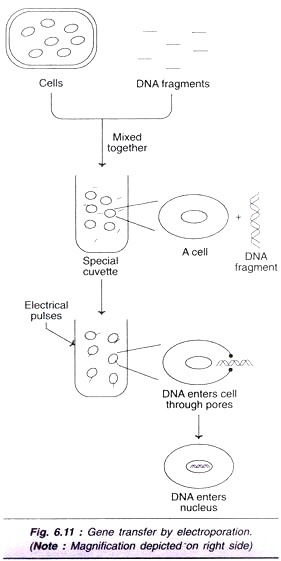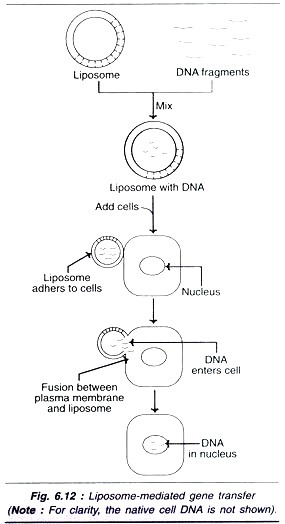This article throws light upon the six methods of gene transfer. The six methods are: (1) Transformation (2) Conjugation (3) Electroporation (4) Liposome-Mediated Gene Transfer (5) Transduction and (6) Direct Transfer of DNA.
Method # 1. Transformation:
Transformation is the method of introducing foreign DNA into bacterial cells (e.g. E.coli). The uptake of plasmid DNA by E.coli is carried out in ice-cold CaCl2 (0-5°C), and a subsequent heat shock (37-45°C for about 90 sec). By this technique, the transformation frequency, which refers to the fraction of cell population that can be transferred, is reasonably good e.g. approximately one cell for 1000 (10-3) cells.
Transformation efficiency:
It refers to the number of trans-formants per microgram of added DNA. For E.coli, transformation by plasmid, the transformation efficiency is about 107 to 108 cells per microgram of intact plasmid DNA. The bacterial cells that can take up DNA are considered as competent. The competence can be enhanced by altering growth conditions.
The mechanism of the transformation process is not fully understood. It is believed that the CaCI2 affects the cell wall, breaks at localized regions, and is also responsible for binding of DNA to cell surface. A brief heat shock (i.e. the sudden increase in temperature from 5°C to 40°C) stimulates DNA uptake. In general, large-sized DNAs are less efficient in transforming.
Other chemical methods for transformation:
Calcium phosphate (in place of CaCI2) is preferred for the transfer of DNA into cultured cells. Sometimes, calcium phosphate may result in precipitate and toxicity to the cells. Some workers use diethyl amino ethyl dextran (DEAE -dextran) for DNA transfer.
Method # 2. Conjugation:
Conjugation is a natural microbial recombination process. During conjugation, two live bacteria (a donor and a recipient) come together, join by cytoplasmic bridges and transfer single-stranded DNA (from donor to recipient). Inside the recipient cell, the new DNA may integrate with the chromosome (rather rare) or may remain free (as is the case with plasmids).
Conjugation can occur among the cells from different genera of bacteria (e.g Salmonella and Shigella cells). This is in contrast to transformation which takes place among the cells of a bacterial genus. Thus by conjugation, transfer of genes from two different and unrelated bacteria is possible.
The natural phenomenon of conjugation is exploited for gene transfer. This is achieved by transferring plasmid-insert DNA from one cell to another. In general, the plasmids lack conjugative functions and therefore, they are not as such capable of transferring DNA to the recipient cells. However, some plasmids with conjugative properties can be prepared and used.
Method # 3. Electroporation:
Electroporation is based on the principle that high voltage electric pulses can induce cell plasma membranes to fuse. Thus, electroporation is a technique involving electric field-mediated membrane permeabilization. Electric shocks can also induce cellular uptake of exogenous DNA (believed to be via the pores formed by electric pulses) from the suspending solution.
Electroporation is a simple and rapid technique for introducing genes into the cells from various organisms (microorganisms, plants and animals).
The basic technique of electroporation for transferring genes into mammalian cells is depicted in Fig. 6.11. The cells are placed in a solution containing DNA and subjected to electrical shocks to cause holes in the membranes. The foreign DNA fragments enter through the holes into the cytoplasm and then to nucleus.
Electroporation is an effective way to transform E.coli cells containing plasmids with insert DNAs longer than 100 kb. The transformation efficiency is around 109 transformants per microgram of DNA for small plasmids (about 3kb) and about 106 for large plasmids (about 130 kb).
Method # 4. Liposome-Mediated Gene Transfer:
Liposomes are circular lipid molecules, which have an aqueous interior that can carry nucleic acids. Several techniques have been developed to encapsulate DNA in liposomes. The liposome- mediated gene transfer, referred to as lipofection, is depicted in Fig. 6.12.
On treatment of DNA fragment with liposomes, the DNA pieces get encapsulated inside liposomes. These liposomes can adher to cell membranes and fuse with them to transfer DNA fragments. Thus, the DNA enters the cell and then to the nucleus. The positively charged liposomes very efficiently complex with DNA, bind to cells and transfer DNA rapidly.
Lipofection is a very efficient technique and is used for the transfer of genes to bacterial, animal and plant cells. T
Method # 5. Transduction:
Sometimes, the foreign DNA can be packed inside animal viruses. These viruses can naturally infect the cells and introduce the DNA into host cells. The transfer of DNA by this approach is referred to as transduction.
Method # 6. Direct Transfer of DNA:
It is possible to directly transfer the DNA into the cell nucleus. Microinjection and particle bombardment are the two techniques commonly used for this purpose.
Microinjection:
DNA transfer by microinjection is generally used for the cultured cells. This technique is also useful to introduce DNA into large cells such as oocytes, eggs and the cells of early embryos. The term transfection is used for the transfer DNA into eukaryotic cells, by various physical or chemical means.

